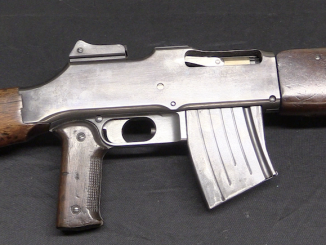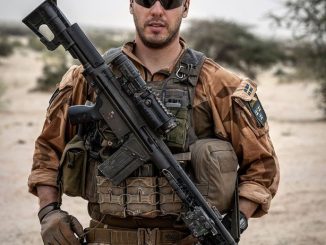Since I have the rather unusual opportunity to examine both the early Swedish m/45 and the improved m/45B at the same time, I figured this would be a good opportunity for a video. There were three substantial changes made to the m/45 when it was improved:
– Barrel proud holes made taller to make the shroud sturdier
– Magazine well guide was riveted permanently in place, as the quad-stack magazines were taken out of service.
– Receiver endcap and buffer were strengthened to better handle the new hotter m/39B AP ammunition
In addition, the m/45B guns were given a coat of heavy green paint over their parkerizing for better durability. Most of the early m/45 gun in service were updated to m/45B standard.




The “Cadillac” (or Saab? Volvo?) of Sten guns!
Apparently there was a sport shooting association in Sweden, where these open-bolt guns are fired semi-auto for score… Sounds challenging, but also probably addicting to participants. Has got to be fun.
Its still a sport in sweden. I shoot sometimes with M/45B
Great to hear! Sounds like a lot of fun. Tack tack!
http://www.gotavapen.se/gota/artiklar/kpist/swede_45.htm claims that
The machine gun m45 has become a popular gun for competitions in Sweden and recently in the Baltic states. The gun has high precision.
Very qualified shooters in civilian shooting clubs have been allowed to buy the m/45B for competitions.
In military M45 competitions here in Ireland in the 1970’s/1980’s, firing single shot was a disqualification offence. Really skilled shooters could achieve single shot but at a speed that the range judges couldn’t catch you. (the slow ROF helped with this) There was one Armoured unit in the Southern Command who were infamous for perfecting this skill.
Thank you, Ian. You solved a 50-year mystery. In /Donald Hamilton’s 1960 “The Wrecking Crew” his protagonist, Matt Helm, used an unidentified submachine gun that Matt swiped from a dead enemy agent to kill master spy Caselius. That submachine gun and a matching gun were part of Caselius’s spy gang’s arsenal–along with a high-power rifle of some sort and a couple of pistols. The thing throwing me off was that all the M/45B submachineguns I knew of were full-auto only.
The Swedish K M/45D would have been appropriate in the story as the M/45D was a police weapon. Select-fire for police is important due to target selectivity–even though the Swedish K isn’t exactly a precision arm. For most shooters, a slam-fire submachine gun set on semi will be more accurate than a pistol and is more likely to put bullets only on the intended target–as long as that target is large enough. Helm’s narrative didn’t discuss range, but a forest cabin indicated to me that the range wasn’t 500 meters. Since the gun was Made in Sweden and police issue, it’s most likely the Caselius gun.
Thanks. You solved a 50 year mystery.
This was the primary armament of the Swedish Army in Vietnam
LOL
I suppose this is pun intended against some U.S. movie which I do not know, which is anyway more plausible than titular character of Pretty Boy Floyd who use M/45… in 1930s
http://www.imfdb.org/wiki/Pretty_Boy_Floyd#Carl_Gustav_M.2F45
I recently watched on DVD a British-made spy thriller from the late 1960s that starred the American George Peppard. The climactic gunfight was set in Greece, and both the KGB and the CIA personnel were armed with improbable Rexim-Favor SMGs. Of course everybody knowledgeable who watched “Raiders of the Lost Ark” screamed at the MP40s that somehow appeared in Egypt in 1938 ….
Col. B’s joke is that the gun fought in Vietnam (in US hands), even though the Swedish army was not actually there.
Everybody knows that every German soldier under a certain unmentionable regime was armed with 1) An MP40 2) Stick grenades (including one tucked into a boot top) 3) A P08 pistol (maybe a P38). Would anyone besides gun nerds like us have noticed if they were were carrying the correct, for the SS, Erma EMP (“MP34”) SMG’s? And they wearing tropical uniforms of the sort first issued to the Afrika Korps in 1941, complete with the iconic M41 field cap. Maybe the MP40’s in ROTLA were really prototype MP38’s issued for field trials?
“Everybody knows that every German soldier under a certain unmentionable regime was armed with 1) An MP40”
https://www.bing.com/videos/search?q=supernatural+golem&&view=detail&mid=029A635BA2F7CAF5DF89029A635BA2F7CAF5DF89&&FORM=VRDGAR&ru=%2Fvideos%2Fsearch%3Fq%3Dsupernatural%2Bgolem%26FORM%3DHDRSC3
Can’t send all those medical supplies without an escort!
Err, Ian, the 50-rounder quadstack (aka the coffin-mag, rumulipas in Finnish) was THE Swedish magazine for Suomi, as the Finns only used 20-rd double stack sticks and drums, first the 40-rd Lahti (or ‘the Columbus Egg’ magazine, whereas you were required to stack 40 rounds BULLET FIRST into a single file drum – a perfect concentration under fire exercise), then the Koskinen drum (where you were putting 72 rds into quad path drum, but at least head first, not bullet first; does not matter: with 50rd boxes you were bound to have them all collapsed at least once before you filled it). It was the Swedish August Schilstroem who patented the quad-stack ‘coffin’, and it was first used in 56 rds capacity BACK SWEPT configuration to avoid rimlocks, for the first Swedish Suomi, the Kpist m/37 was chambered in 9x20SR Browning Long. It was only in 1939 that the Swedish Suomi was made into the 9×19 Kpist m/37-39 (with the shorter 250 mm bbl instead of the Finnish 320 – same length as the Beretta MAB 38A). SOME coffin mags were imported by the Finns, and then SOME were manufactured at Tikkakoski, but the VAST majority of Finnish magazins seen in the wartime photos were the Koskinen drums (later on copied after the Winter War by the Soviets for the PPD-40 and PPSh-41 in 7.62×25). Other users of the Suomi (the Danish and Swiss) have also chosen the 50-rd quad-stack instead of the drum, they thought too large, unwieldy and heavy (as a matter of fact two 36-ers held the same 72 rds as the drum, but the combined weight is ONE THIRD of the loaded drum. Same weight arythmetics killed the 50-rd quad: 216 rounds in six 36-rd sticks was HALF weight of the 200 rds in 4 coffins, and they fitted in the same magazine pouch). The 36-rounder was a double-feed magazine, making it WAY easier to fill with loose rounds – and if you had the Swedish military 9×19 factory loaded into the 36-rd stripper clips, boy, that made loading magazines a BREEZE. As a matter of fact I clocked 4 seconds with small change to fill a 36 rd magazine using the loading device and stripper clip. Ian – you really should make a separate video about the Swedish Suomi/Kpist 45 magazine fillers. We can talk about that when you cometh. I got all types of magazines and loading devices, including the extremely rare coffin-mag scissors.
The first Kpist m/45 was fed from a proprietory 30-rd stick, you can see already in 1945 edition of the Swedish Manual for the Soldiers (Soldaten-Reglement). The magazine well is open, with no side channels. Then in 1947 edition a new model is shown, with side channels, enabling using the 50-rd coffin mags. BTW – the drums can also be used, but there were no drums in Sweden, so that was just by happy coincidence. In 1954 edition of the S-Reglement there is a new version of the Kpist m/45 – with a magazine channel held in place by the C-clip – just like the parkerized Kpist in your video, down to a big-hole barrel shroud. That’s when the new 36-rds wedge-sectioned magazine was introduced, at the same time in Sweden and Finnland, 1954.
Then the whole manufacturing line was sold to Egypt in 1955 (Port Side is the exact copy of the EARLY model Kpist m/45, complete with the 36-rd magazine), while in Sweden a modified Kpist m/45B is introduced (first shown in S-Reglement for 1958), being green-lacquered, with top hook at the rear, and riveted magazine funnel, and the new small-holed barrel shroud, exchangeable for the Kpist m/45C shroud (also only the small-holer) fitted with the bayonet catch for the Karabiner m/94-14 bayo (375 mm blade). And in the Navy they used it with a Naval m/15 bayonet, which had an even longer blade, 500 mm!